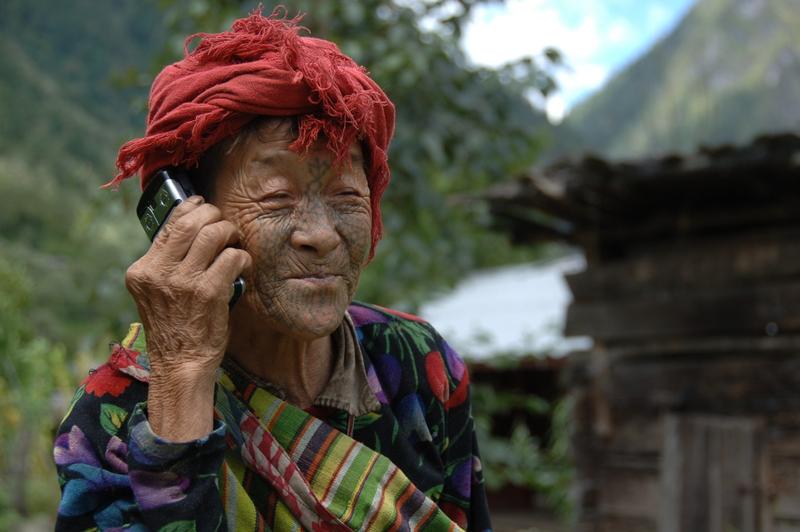 In this undated file photo, a Derung woman, with traditional tattoos on face, from the formerly impoverished Dulongjiang township of Yunnan province, uses a smartphone. (PHOTO PROVIDED TO CHINADAILY.COM.CN)
In this undated file photo, a Derung woman, with traditional tattoos on face, from the formerly impoverished Dulongjiang township of Yunnan province, uses a smartphone. (PHOTO PROVIDED TO CHINADAILY.COM.CN)
Xiong Yulan, 34, still harbors childhood memories of the thundering explosions that once served as signal pistols to summon villagers for rallies.
Firing gunpowder was the most efficient way to send messages in Xiong's hometown, Dulongjiang (Derung River) township in Gongshan, in the early 1990s as no phones were available in the area near the Derung River in Yunnan province.
But in 2019, local residents like Xiong started discovering how 5G can change their lives, with China Mobile, the nation's largest mobile telecom operator, setting up a 5G station in the distant township.
Wearing virtual reality glasses with the support of the 5G network, Xiong was immersed in real-time sceneries of Kunming, Yunnan's provincial capital, about 900 kilometers away.
"It's wonderful. I feel like I'm there," she said. "I want to reach out and touch the buildings and moving cars next to me."
Xiong's township and adjacent areas are a major habitat for people of the ethnic Derung group. The Derung people's journey from no telephones to high-speed 5G networks comes at a time when China is arguably making the world's biggest push to reduce the digital divide between rural and urban residents.
Now thanks to painstaking efforts of local telecom carriers like China Mobile to expand 5G network infrastructure, Dulongjiang, one of the least developed regions in China, is also among the first batch to enter the 5G era
Local telecom operators and tower builders are pouring resources to ensure that more people can access fast, affordable mobile communication and broadband network services.
China Mobile, for instance, has invested more than 160 billion yuan (US$24.7 billion) till the end of last year to improve network infrastructure in poor areas. It has helped more than 120,000 natural villages access telephone services, and more than 80,000 administrative villages gain access to broadband networks.
Such efforts are not just about heavy capital inputs, but also the hard work from frontline employees who have lived and worked in these poor villages, overcome geographical barriers to build telecom base stations, and taught villagers how to use phones.
ALSO READ: 5G to ring in New Year with 'explosive growth'
Take Dulongjiang for instance. The area, once listed as one of the least developed regions in China, did not bid farewell to primitive living until the founding of New China in 1949.
One of the main reasons behind Derung's poverty lies in its geographical complexities. The Derung River region is not only a mountainous area, but also frequently struck by snowstorms in winter as well as landslides and mudslides in summer. About 20 years ago, it used to take three days to walk from Dulongjiang township to the county seat of Gongshan. The township, which did not have the connections to receive telephone calls until 2004, is the last ethnic minority area in China to access basic telephone services.
But in 2014, thanks to the efforts of telecom carriers including China Mobile and China Unicom, Derung became the first ethnic minority group to gain access to 4G services in China.
The process, however, was by no means easy. Ma Chunhai, an employee at China Mobile's Gongshan branch, recalled that every year, only two months offer a prime time for construction in Dulongjiang township and, because of the geographical barriers, it was extremely difficult to transport all the materials needed to build base stations, making the transportation costs incredibly high.
Ma and his colleagues also had to frequently climb over Gongshan Mountain to find appropriate locations to build base stations, even in heavy wind and snow.
But finally, in June 2014, 4G services were commercialized across Dulongjiang township. So far, it is covered by more than 30 base stations, allowing local residents to enjoy the information highway, even though there's no geographical highway connecting the village with the outside world.
In 2015, China Mobile invested nearly 3 million yuan to send about 5,000 of its own-brand smartphones to villagers in Dulongjiang township and help them learn how to use smartphones to sell agricultural products online, watch videos and gain opportunities to acquire more knowledge.
Now thanks to painstaking efforts of local telecom carriers like China Mobile to expand 5G network infrastructure, Dulongjiang is also among the first batch to enter the 5G era.
READ MORE: 5G to fuel traditional sector upgrade
"In the past, the Derung people were secluded from the outside world, but today we keep pace with other regions and even developed coastal cities in terms of 5G technology," said Gao Derong, former head of the government of Gongshan county which administers Dulongjiang township.
Xinhua contributed to this story.


